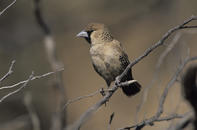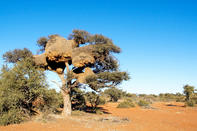
Name
Sociable weaver (Philetairus socius)Appearance
With the sociable weaver, the sexes are basically indistinguishable. They have a black chin and face mask, a brown cap and are distinctively scalloped on the back and flanks.Diet
Being an insectivore, the sociable weaver diet is made up of around 80 % insects with the balance being seeds.
This weaver feeds extensively on harvester termites. In extremely arid areas, with no available water, the sociable weaver obtains all its water needs from insects. Sociable weavers forage on the ground and in trees within 1.5 km of the nest.
Sociable Weaver Breeding

The sociable weaver is mostly monogamous and breeds cooperatively, with up to 9 helpers being recorded. The breeding season normally follows the rains.
The female will lay between 2 and 6 eggs. The eggs are brooded by both parents, plus helpers, for around 14 days. The chicks are fed by both parents and assisted by the helpers for another 21 days.
Behaviour
Sociable weavers maintain and build their nests throughout the year. The nest is a colony, which can be built by as many as 10 to 500 birds. The sociable weaver nests can be recognised from far, they look like haystacks built above the ground, in a tree or a telephone pole or electrical pole in treeless areas.
The sociable weaver nests are considered the largest nest in the avian world and is built almost entirely of grass.
The nests are very efficient at maintaining a constant temperature, especially in the extremes of winter and summer.
This temperature insulation works by conserving the energy of the birds in winter, which leads to a lower food intake, making it easier for the birds to survive the winter when food supplies are low. Sociable weaver nests are used by a wide array of other species of birds for breeding.
The pygmy falcon, red-headed finches, pied barbets and rosy-faced lovebirds have been recorded nesting in weaver nests.